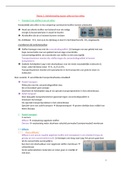Exam (elaborations)
Patent Ductus Arteriosus NCLEX Review, (PDA) NCLEX Questions (solution) all correct
- Course
- NURS 3622
- Institution
- Southwest Texas Junior College
Patent Ductus Arteriosus NCLEX Review, (PDA) NCLEX Questions (solution) all correct-What is patent ductus arteriosus? It’s a congenital heart defect where the ductus arteriosus does NOT close after birth. This will lead to an increase in pulmonary blood flow. When you are studying congenital h...
[Show more]












